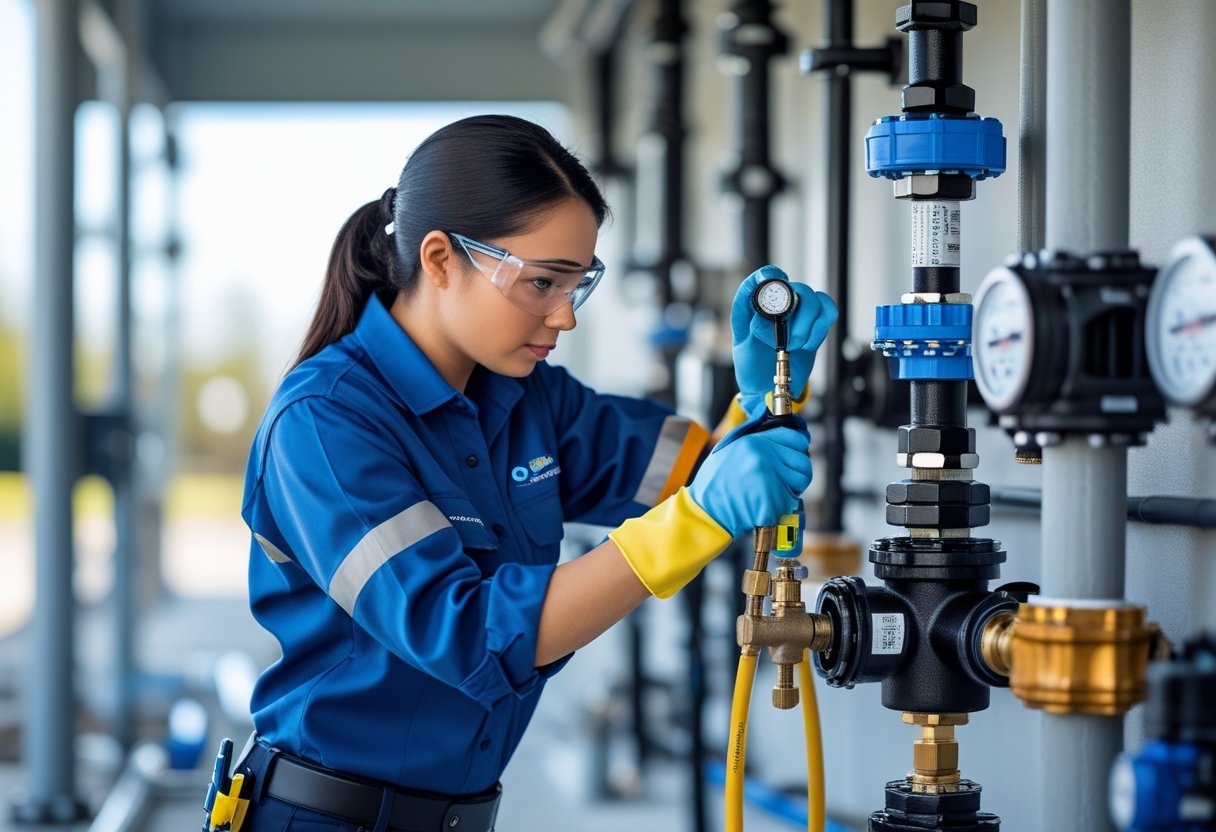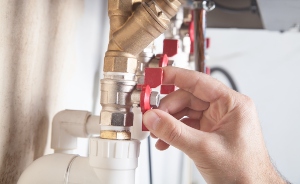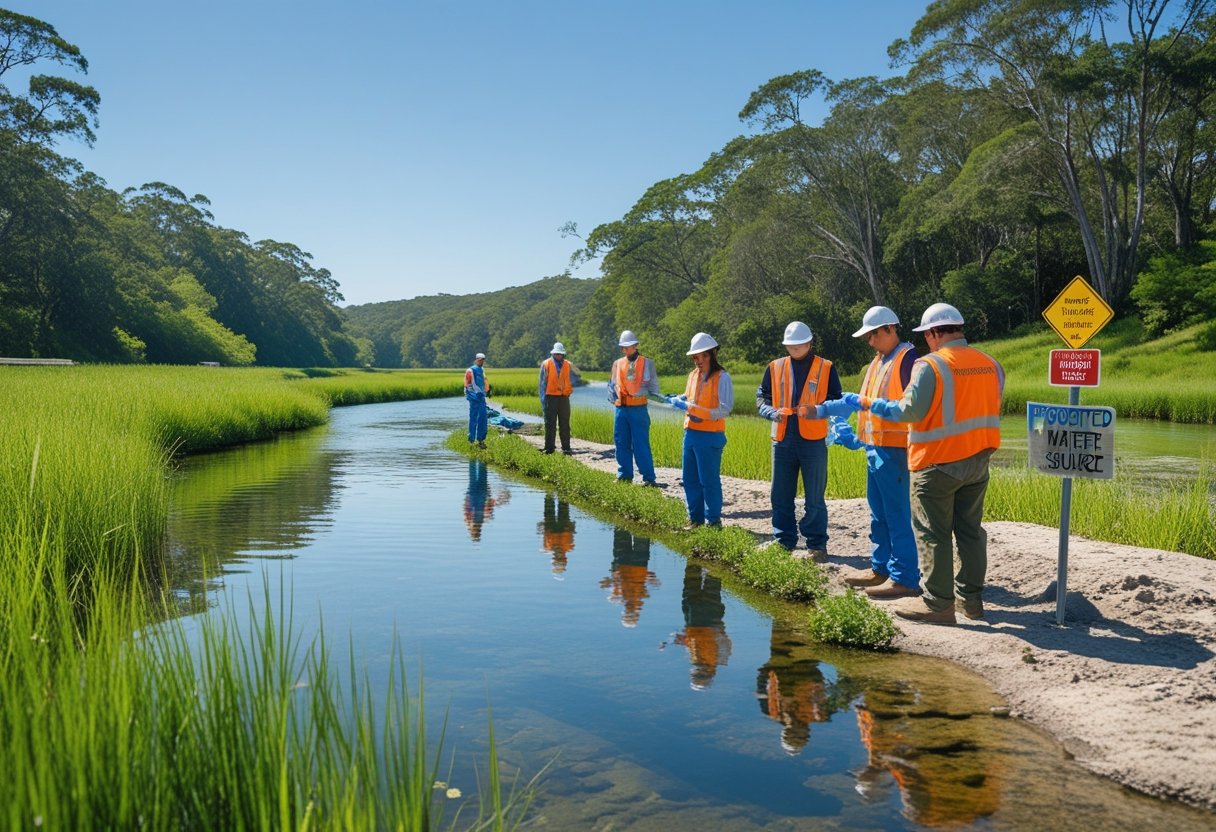Preventive backflow maintenance keeps your water safe and clean. By regularly testing and maintaining your backflow preventer, you block harmful contaminants from entering your water supply, protecting your health and property. This simple habit helps you avoid expensive repairs and stressful emergencies down the line.
When your backflow device works as it should, you also stay on the right side of local regulations—no fines, no water shut-offs. Pacific Backflow, serving all of San Diego County, handles backflow maintenance with quick, reliable testing and skilled repairs whenever you need them. Looking after your backflow system really does protect both you and your neighbors.
Understanding Backflow and Its Risks
Backflow lets unsafe water sneak into your clean water supply. Understanding what causes it and the risks involved helps you protect your home or business. Keeping water safe means stopping harmful stuff before it ever reaches your taps.
What Is Backflow?
Backflow happens when water moves in the wrong direction. Instead of flowing away from your water supply, dirty or contaminated water pushes back into it. This usually happens because of sudden changes in pipe pressure—like when a water main breaks or someone shuts off a pump in a hurry.
Any water system can face backflow problems, from houses to huge buildings. That’s why backflow preventers matter—they keep water moving one-way only. These devices help make sure your water stays clean for drinking, cooking, and cleaning.
Common Causes of Backflow
There are two main reasons backflow happens: backpressure and backsiphonage.
- Backpressure pops up when something inside your plumbing—like a pump, boiler, or other equipment—pushes water pressure higher than usual, forcing water backward.
- Backsiphonage occurs if the water pressure drops so low that it actually pulls water back into the supply. This can happen during heavy water use, firefighting, or a busted main.
Cross-connections, like those between your drinking water and things like lawn sprinklers or industrial equipment, make backflow risks even higher.
Potential Hazards of Backflow Events
Backflow can drag in chemicals, dirt, and germs—none of which you want in your water. These contaminants can cause health risks, from stomach bugs to exposure to nasty substances.
Contaminated water doesn’t just stay in the pipes; it affects your whole home or building. Drinking, cooking, or even washing with unsafe water puts everyone at risk. Plus, backflow can lead to expensive repairs and headaches with the law if your water supply violates safety codes.
Regularly maintaining your backflow preventer, like with Pacific Backflow’s service in San Diego County, helps you dodge these problems. Testing and repairs keep your water safe and up to code.
What Is Preventive Backflow Maintenance?
Preventive backflow maintenance keeps your water safe by making sure backflow preventers do their job. It’s all about regular checks and care to stop dirty water from sneaking into clean supplies. This routine saves you money and helps you follow local rules.
Key Components of Preventive Maintenance
Preventive maintenance covers inspection, testing, cleaning, and repair. Inspections spot visible damage or wear. Testing checks if your backflow preventer blocks water from reversing.
Cleaning clears out debris that might clog the device. Repairs fix leaks, swap out worn parts, or even call for a new preventer if things are really bad.
You’ll want to do these tasks regularly—usually once a year. That keeps your system running smoothly. Certified pros make sure your tests and repairs meet all the standards.
How Preventive Maintenance Works
You set up an annual test with certified testers. They check the backflow preventer. If it’s working, you get a report to prove it.
If they find something wrong, they’ll suggest repairs or a replacement. Fixing issues quickly stops contamination and keeps you out of trouble with local water authorities.
Maintenance also means protecting your device from damage or tampering. Adding cages or covers helps. Regular care lowers the risk of sudden failures that could threaten water safety.
Who Needs Preventive Backflow Maintenance
If you own or manage property with a backflow preventer, you need preventive maintenance. That’s homes, businesses, schools, hospitals, industrial sites—any place hooked up to public water.
Commercial properties need maintenance to keep public water safe from chemicals or waste. Cities and counties enforce these rules, so keeping your device in shape means you avoid penalties.
Here in San Diego County, Pacific Backflow offers dependable backflow testing and maintenance. We help property owners protect their water supply with quick, no-fuss service that checks every box for local requirements.
Health and Safety Benefits
Preventive backflow maintenance keeps your water clean, cuts down your risk of chemicals or bacteria getting in, and helps your whole community stay healthy. Looking after your backflow preventer is just a smart move.
Protecting Drinking Water Quality
Your drinking water can get contaminated if backflow happens. That’s when dirty water flows backward into your clean pipes. Backflow preventers keep water moving the right way.
Regular maintenance makes sure your device works. A well-kept preventer blocks dirt, chemicals, and germs from reaching your tap. You get clean, safe water every day.
Annual inspections and repairs, like those from Pacific Backflow, help your backflow device meet safety rules and keep your water pure.
Reducing Exposure to Contaminants
If a backflow preventer fails, stuff like pesticides, sewage, or cleaning chemicals can mix with your water. That’s a recipe for illness or allergic reactions.
If you schedule regular testing and fix problems fast, you lower the odds of running into these dangers. Preventive maintenance acts like a warning system, catching trouble before it gets serious.
You’ll feel better knowing your water’s protected from hidden pollutants that could put your family’s health at risk—especially if you have kids, elderly relatives, or anyone with a weaker immune system at home.
Supporting Community Health
Backflow issues don’t just affect you—they can mess up the whole water system for your neighbors, too. Contaminated water can spread fast through shared pipes.
When you keep up with backflow maintenance, you help keep everyone’s water clean. That means fewer outbreaks of waterborne sickness and safer local water.
Pacific Backflow has been serving San Diego County since 1982, helping thousands of homes and businesses stay protected. When everyone chips in, we all get safer water, every day.
Financial and Legal Advantages
Looking after your backflow prevention system saves money and helps you steer clear of legal headaches. Regular maintenance catches problems early, keeps you compliant, and shields you from fines that can blow up your budget.
Avoiding Costly Repairs
If you skip maintenance, backflow devices can break down and cause expensive messes. When these systems fail, contaminated water might leak or back up, leading to repairs not just for the device, but for your plumbing and property, too.
Regular testing and upkeep spot trouble before it gets big. Fixing a small leak or swapping out a worn part costs way less than replacing the whole unit or dealing with water damage. Annual inspections from pros like Pacific Backflow in San Diego County keep your system working and your costs down.
Minimizing Legal Liabilities
If your backflow device fails, you could be on the hook for any water contamination that hurts public health. That can mean lawsuits or demands for compensation if people get sick or property gets damaged.
You’ve got to maintain and test your backflow preventers as the law requires. Keeping records of testing and repairs shows you did your part. That lowers your legal risks and helps protect you from claims of negligence.
Preventing Fines and Penalties
Most places require annual backflow testing and certification. Miss those deadlines, and you could face fines or other penalties, depending on your property and the local rules.
Staying on top of testing and maintenance keeps you out of trouble. Report your tests on time and fix what needs fixing to keep your system certified. Pacific Backflow helps you meet all San Diego water district requirements, so you don’t get hit with surprise fines.
Key points:
BenefitDetails Avoiding expensive fixesCatch issues early through regular checksLower legal riskMaintain records to prove complianceAvoiding finesMeet annual testing and repair deadlines
Extending Equipment Lifespan
Taking care of your backflow preventer helps it last longer and work better. Good maintenance lowers risks like leaks or valve problems. You’ll deal with fewer repairs and almost never face a big system meltdown.
Reducing Wear and Tear
Regular inspections catch small problems before they get out of hand. If valves stick or seals wear out, fixing them early keeps other parts safe. This cuts down on stress to your backflow preventer.
Think of maintenance as a tune-up that keeps everything humming. Cleaning the device and adjusting parts makes sure it reacts fast if something goes wrong. Over time, this careful attention slows down wear and keeps things running for years.
By reducing friction and pressure on moving parts, you avoid breakdowns that could cost a fortune. These small steps make your backflow device more reliable, so you’re not caught off guard by failures.
Preventing System Failures
Backflow system failures can let contaminated water into your supply. You definitely want to avoid that. Annual testing and tune-ups catch hidden flaws or worn parts.
If something breaks, you could end up with leaks or a full shutdown. Regular maintenance means you catch and fix issues fast, stopping bigger damage before it starts.
With the right care, you’ll have fewer emergencies and less downtime. Services like Pacific Backflow’s mean trained technicians test and repair your device quickly. That keeps your water safe and your property up to code.
Getting ahead of problems now saves you from bigger headaches later—and keeps your water supply secure.
Supporting Regulatory Compliance
Preventive backflow maintenance keeps you out of legal trouble and ready for inspections. It also helps your water supply meet safety standards, no matter what.
Meeting Local and Federal Standards
You’re required by law to maintain your backflow prevention devices according to local and federal rules. These laws protect public health by stopping water contamination.
Annual testing by certified techs is usually a must. Skip it, and you could face fines or even a shutdown. Regular maintenance proves your device works and keeps your property compliant.
Keep your records of testing and repairs organized. These show you followed the rules and help avoid penalties or delays from water authorities. Pacific Backflow can file these reports for you, making compliance a lot less stressful.
Staying Prepared for Inspections
Inspections can happen any time, sometimes with barely any warning. Keeping your backflow preventer in good shape means you’re always ready. That takes the pressure off and helps you breeze through inspections.
Preventive maintenance lets pros catch small issues before they turn into disasters. That saves you money and helps keep your water safe.
Having a team like Pacific Backflow on call means expert help is never far away. Their crew keeps your equipment working so you pass inspections year after year.
Promoting Environmental Responsibility
Preventive backflow maintenance keeps your water clean and, during emergencies, stops harmful substances from getting into your system. It also saves community resources by avoiding costly repairs and waste. All of this supports a healthier environment and better water quality for everyone.
Preventing Water Pollution
Backflow prevention stops dirty or polluted water from mixing with clean drinking water. Without regular maintenance, chemicals, bacteria, and waste can get into your water supply. That’s bad news for your health and the environment.
By keeping your backflow preventer in good shape, you lower the risk of harmful pollution. This protects rivers, lakes, and groundwater from contamination. Clean water helps wildlife and keeps natural ecosystems thriving.
Regular testing and repairs help you spot problems early—before pollution happens. It’s a simple step, but it makes a big difference in keeping water safe for you and your community.
Conserving Community Resources
When backflow devices break down, fixing them can get expensive and take a lot of time. Staying ahead with regular maintenance just makes sense—it keeps you from scrambling during emergencies or dealing with water damage that could've been avoided. Water districts appreciate it too, since it takes some pressure off local supplies.
If you look after your backflow setup, you'll see fewer leaks and less water going down the drain for no good reason. And let's be honest, water's not something we can afford to waste in San Diego County. Every bit saved now helps make sure there's enough for everyone later.
Going with a service you trust, like Pacific Backflow, helps keep your preventers working as they should all year. It’s good for your system and, honestly, for the whole neighborhood.
Peace of Mind for Property Owners
Regular backflow maintenance can save you from a world of headaches. It keeps your water safe and cuts down on the odds of those annoying surprise repairs or sudden shutoffs. Things just run smoother when you stay on top of it.
Ensuring Reliable Water Supply
Keep your backflow preventer in check, and your water stays clean. If something goes wrong, dirty water could sneak back into your system—nobody wants that. Simple testing and routine upkeep make sure everything’s doing its job day in, day out.
You can count on pros like Pacific Backflow to handle testing, repairs, and installations across San Diego County. They know the codes and keep you out of trouble. With your maintenance up to date, there’s no need to stress about water quality or unexpected interruptions.
Reducing Emergency Situations
Staying proactive with maintenance means you’ll see fewer sudden breakdowns. When backflow preventers get ignored, they can leak or fail, leading to contamination or even losing water service.
Book those yearly tests and quick repairs before trouble starts. It’s less hassle, less stress, and fewer nasty surprises. Fast-acting services like Pacific Backflow keep your system steady and your property protected.
How to Set Up a Preventive Maintenance Program
A solid maintenance plan keeps your backflow preventer working right and your water supply protected. Set up a regular schedule for inspections, and make sure you’ve got people who actually know what they’re doing for any testing, repairs, or installations. It’s how you dodge big problems and stay on the right side of safety rules.
Scheduling Regular Inspections
Book annual backflow inspections to catch issues early and keep up with local codes. Regular tests make sure the device’s working and help you avoid contamination.
Set reminders—on your phone, calendar, whatever works—to keep track of inspection dates. Don’t wait until the last minute. If a test turns up a problem, get repairs done right away.
Hold onto records of inspections, results, and any fixes you’ve made. You’ll need that paperwork to prove you’re following the rules and to make future maintenance easier. Having a clear inspection plan really does save you headaches later.
Choosing Qualified Professionals
Always go with certified backflow testers and repair folks. Only people who know local regulations and proper testing methods will get your system up to code.
Look for techs with real experience and the right licenses. Pacific Backflow covers San Diego County and brings certified testers who even handle the reports for you.
Ask them about their process and how they manage repairs or replacements if something’s wrong. Good communication and thorough work go a long way. When you trust the team, you can relax knowing your water’s safe and your device is in good shape.
Frequently Asked Questions
Taking care of your backflow system helps you save money, keep your water safe, avoid big surprises, and stay on the right side of local rules. Knowing how often to check your device and what can go wrong if you skip maintenance makes it easier to protect your property and your neighbors.
What are the long-term cost savings of conducting regular backflow prevention maintenance?
Regular maintenance catches small issues before they snowball. You avoid pricey repairs, replacements, and fines for failed inspections—that’s money in your pocket over time.
How does preventive maintenance on backflow devices protect water quality?
Keeping your backflow preventer clean and in working order blocks dirty water from mixing with your clean supply. That’s how you keep your home or business safe from contamination.
Can routine backflow maintenance help avoid costly repairs or replacements?
Absolutely. Regular checks catch leaks, worn parts, or damage early. Fixing them right away means you’re less likely to face a total breakdown or need to buy new equipment.
Why is it important for compliance to schedule backflow system check-ups?
Most water districts require annual or regular testing. Scheduling those check-ups keeps you compliant and makes sure your system’s working like it should—protecting everyone’s water.
What are the risks of neglecting backflow preventer maintenance?
Skip maintenance, and your device could fail without warning. That can mean water contamination, emergency repairs, fines, or even health risks for anyone using the water.
How often should backflow prevention systems be inspected for optimal performance?
Generally, folks suggest getting these systems checked once a year. That said, certain setups or places might call for inspections more often. Having professionals—think Pacific Backflow or your trusted local crew—take a look helps keep everything running smoothly and up to code.











